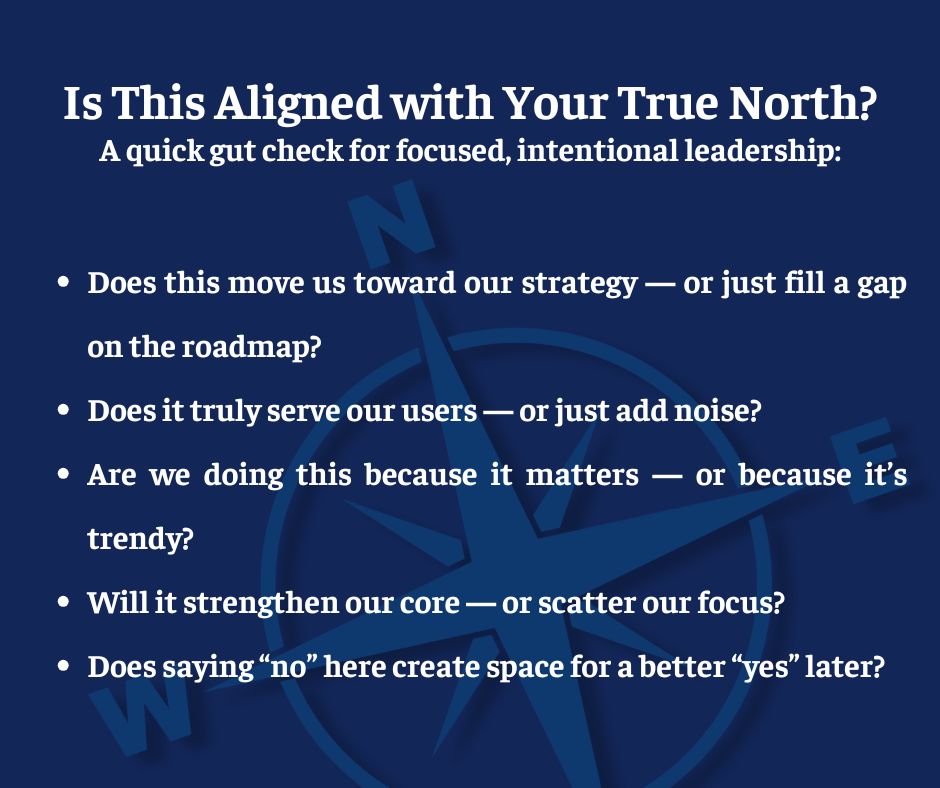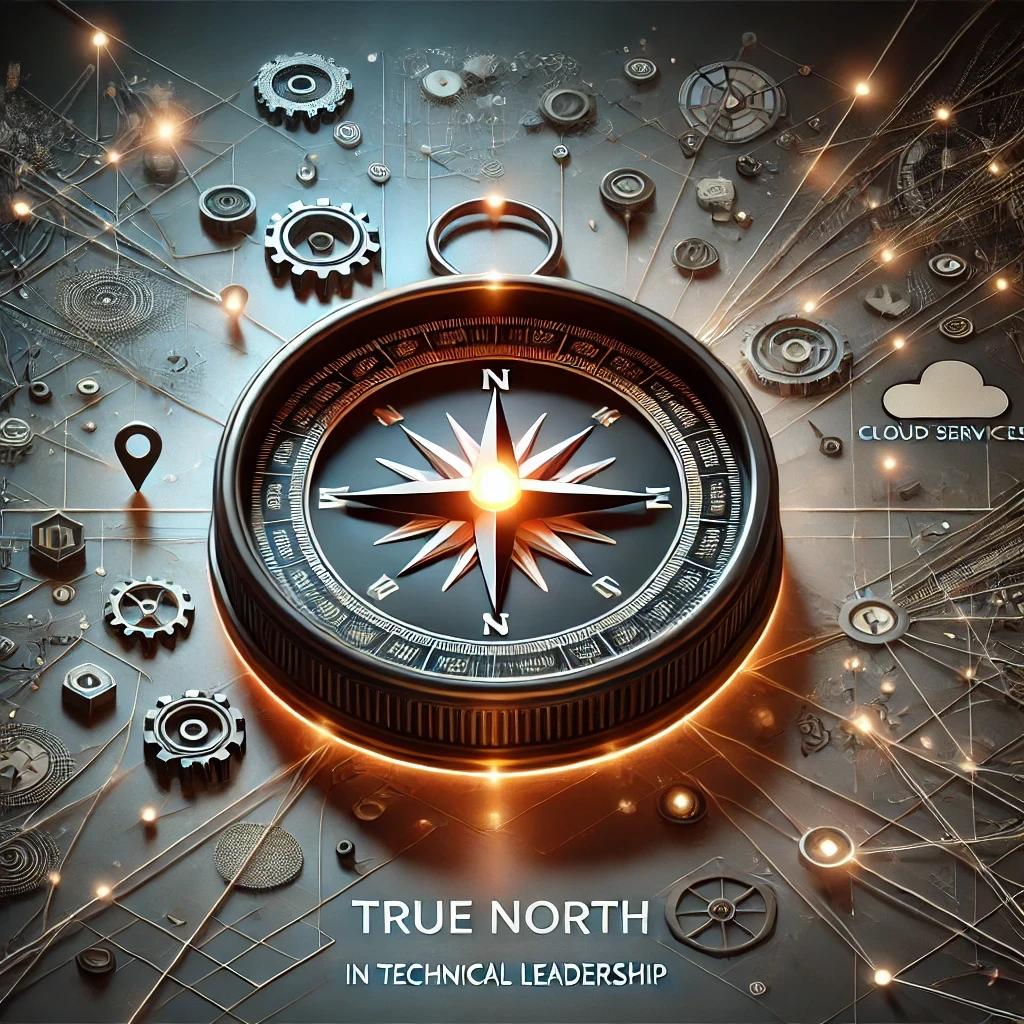Why Leaders Lose Focus
In a world where the pace of innovation is measured in milliseconds, technical leaders face a constant barrage of shiny objects. Avoiding distractions as a technical leader can be almost impossible. New tools. New frameworks. New buzzwords.
For example, lately, there has been an avalanche of AI tools with names that sound like startup Mad Libs: QuokkaGPT, NeuralNoodle, Promptzilla, AutoGenie, and SynthifyPro++ (yes, that’s a real thing — maybe). Every week, a new AI assistant promises to revolutionize your workflow, streamline your pipelines, and probably make your coffee, too — if only you onboard it before lunch.
It’s a circus of innovation—dazzling, noisy, and chaotic enough to derail even the most seasoned leadership team.
But here’s the truth: leadership isn’t about chasing — it’s about anchoring. It’s about knowing where you’re going even when the winds of change are blowing at full force. That’s where your “True North” comes in.
Simon Sinek has a similar concept, which he calls your “Why.” In Start With Why, he makes the case that great leaders inspire action by anchoring their decisions in a clear, purpose-driven foundation. In The Infinite Game, he takes it even further: leadership isn’t about quarterly wins — it’s about building something enduring. Something that outlasts you.
While similar to Simon Sinek’s concepts, for us technical leaders, True North should be a little different.
What Is a True North in Technical Leadership?
Your True North is your compass. It’s the unchanging direction that guides your decision-making, your team’s priorities, and your strategic vision. While tactics evolve and goals shift, your True North stays constant.
It’s the reason you say “yes” — and, more importantly, the reason you say “no.”
It’s the force that prevents your team from getting swept up in every trend or request. It helps you make tough calls with clarity and confidence. Because without a True North, you’re not leading — you’re just reacting.
Why Distraction is the Silent Killer of Technical Teams
Distraction rarely walks in the front door wearing a name tag. It creeps in quietly, disguised as “opportunity.”
A new integration. A requested feature from one department. A flashy tool your competitor is using. Before you know it, your roadmap looks like a dartboard — and no one remembers what the original mission even was.
I am as guilty of this as anyone else. (Because some of those AI tools are cool!)
I’ve seen teams grind to a halt, not because they lacked talent, but because they lacked focus. They were shipping features no one asked for, reworking things that didn’t need fixing, and chasing tech debt like a dog chasing its tail. And the saddest part? Everyone was exhausted — and none of it moved the needle.
Sometimes, it’s not just the technical team. Most of us have had CEOs who are distracted by every shiny object out there. That distraction can trickle down.
Case Study: Yahoo – The Cautionary Tale
Let’s talk about Yahoo.
At one time, Yahoo could have been the internet powerhouse. It had everything — email, search, news, media, and even early social networking tools. But instead of doubling down on a core strength, Yahoo tried to be everything to everyone.
Do you remember the old Yahoo home page? It was painful to look at. You didn’t know where even to look. What a perfect representation of a company that couldn’t stay focused. I personally don’t think their current page is any better…
They acquired platforms like Tumblr without a strategy, launched half-baked video services, and dabbled in search while Google raced ahead with laser focus. There was no cohesive vision — just a swirl of initiatives pulling in different directions. The result? Confusion, decline, and ultimately, irrelevance.
Yahoo didn’t fail because it lacked talent. It failed because it lacked a True North.
Case Study: Apple – The Power of Strategic Focus
Now contrast that with Apple under Steve Jobs. Jobs took a different approach to avoiding distractions as a technical leader.
When Jobs returned in 1997, Apple was drowning in product sprawl — dozens of product lines with little cohesion. Jobs famously canceled 70% of Apple’s product offerings. Not because those products were bad, but because they weren’t essential to the vision.
Among the cuts were products like the Newton MessagePad (an early personal digital assistant), the Apple QuickTake camera (a digital camera that was ahead of its time but not aligned with the company’s direction), the Macintosh Performa line (an overly complex and confusing consumer desktop lineup), and several other redundant or underperforming product lines. Jobs also shelved various software projects and accessories that had little strategic value.
The message was clear: Apple wasn’t going to be in the business of doing everything — it was going to be in the business of doing a few things exceptionally well.
That ruthless clarity paved the way for iconic products like the iMac, iPod, and, eventually, the iPhone. Jobs understood what many leaders forget: focus is a superpower. Every “no” he said made room for a better “yes” — and those better yeses became category-defining, market-dominating innovations.
His strategic discipline was not about minimalism for its own sake but about making space for greatness to emerge. That kind of leadership doesn’t just declutter your roadmap — it sharpens your impact.
How to Find and Follow Your True North
So, how do you uncover your own True North?
Let’s clarify something upfront — True North isn’t the same as your organizational “Why.” While “Why” represents your fundamental purpose — the big-picture reason your organization exists — True North is more actionable. It’s the focused translation of that purpose into day-to-day decisions. It’s where vision meets execution.
Your True North doesn’t live in a mission statement laminated on a wall. It lives in your meeting agendas, your product roadmap, and your decision-making filter.

It’s the practical lens that helps you decide what’s worth your time, your talent, and your team’s energy.
Here are a few questions to help you determine if a decision aligns with your True North — the practical compass that keeps your team focused, grounded, and moving with purpose:
- Does this project move us closer to our strategic direction — or just fill a gap on the roadmap?
- Does this feature meaningfully serve our users — or just add noise to our product?
- Are we pursuing this initiative because it supports our mission — or because it’s the latest industry buzzword?
- Will this decision strengthen our core capabilities — or scatter our focus?
- Does saying “no” here allow us to protect the space for a much better “yes” down the road?
Your True North allows you to steer with consistency, even as the terrain shifts beneath you. Use the principles from The Infinite Game to pressure-test your direction — but let your True North shape how you act in that direction, one decision at a time.
Anecdotes from the Field: Saying No to the Shiny Things
Every leader has their “shiny object” moment. Avoiding distractions as a technical leader is difficult for me, too.
I once had a team ready to integrate a trendy new analytics dashboard because — well — everyone else was doing it. But when we stepped back and looked at our core mission, it didn’t align. It was cool but unnecessary. We said no. We doubled down on improving the reporting tools our users actually used. And guess what? Adoption went up. Engagement improved. And our team got to celebrate meaningful progress, not superficial flair.
That wasn’t the only time I saw the power of a well-placed “no.” In another case, a project team wanted to take on a request from another department that sounded exciting — but it would’ve required reworking half of our platform. We evaluated it against our True North and realized it wasn’t worth the diversion. Saying no preserved our team’s momentum and allowed us to deliver a high-impact feature on schedule instead. That’s the kind of decision that earns trust and drives real performance.
Saying “no” isn’t always easy — but it’s almost always worth it. Sometimes, the most strategic decision you can make isn’t choosing between good and bad — it’s choosing between good and better aligned.
If you’d like to dive deeper into how saying “no” can unlock performance and sharpen your leadership impact, check out my related article: Driving Team Performance: The Surprising Power of Saying No.
Closing Thoughts: Lead With Vision, Not Volume
True leadership isn’t about delivering more — it’s about delivering what matters most. Your True North keeps your team grounded when everything else feels chaotic. It’s the silent force behind momentum, morale, and mission clarity — and it’s what helps you cut through the noise when the world feels like a never-ending demo of the latest AI-powered, cloud-optimized, blockchain-enhanced productivity tool.
So the next time a new tool, feature, or initiative crosses your desk — whether it’s a legitimately promising opportunity or just the latest hype train called “SynergyIQ Turbo Pro” — pause and ask yourself:
“Does this move us closer to our purpose — or just further from our focus?”
Because in a noisy world, a leader with clarity is a rare and powerful force.
And remember — your True North isn’t just a guiding concept; it’s a leadership filter. It’s what helps you resist the gravitational pull of every new tool, feature, or initiative that promises quick wins but pulls you off course. It’s what brings discipline to your decision-making, focus to your team, and clarity to your path forward.
Sometimes, that clarity means saying “no” — not just for the sake of efficiency, but to make room for what truly aligns with your direction. Saying no isn’t about being resistant to change — it’s about being committed to what matters most. It’s not about rejecting innovation; it’s about choosing meaningful innovation over noisy distractions.
Because when you lead from True North, every decision — yes or no — becomes sharper, bolder, and more intentional.


